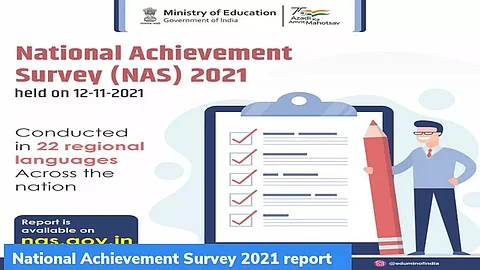
- Home
- Live Blog
- Breaking News
- Top Headlines
- Cities
- NE News
- Sentinel Media
- Sports
- Education
- Jobs

Ravindra Kumar Mishra
(Former Chief Consultant,
Union Ministry of Education (formerly MHRD.
He can be reached at rkmishrajee@gmail.com)
The Ministry of Education has released National Achievement Survey (NAS) 2021, one of the largest surveys in the world. This assesses the status of the school education system across the country by conducting a comprehensive survey that disseminates educational attainments of children of Class III, V, VIII and X every three year. The report is available at nas.gov.in
The survey, conducted in one single day across the country, has been designed by NCERT, technological platform provided by the NIC and administered by the CBSE. It captures student achievement of learning outcomes at the end of Classes III, V, VIII and X, through an OMR based achievement test comprising of Multiple-Choice Questions (MCQs). It assesses competencies and skills achieved by the students at different levels of school education through meticulously developed and field-tested items.
It reveals that NAS 2021 will help to unravel the gaps in learning and will support state/UT governments in developing short-term, mid-term and long-term interventions to improve learning levels and orient differential planning based on this data.
The report is based on the performance in all subjects through disaggregation by gender (female, male), Area (Rural and Urban), Management of schools (Government, Government aided and Private unaided) and Social Groups (Scheduled Caste (SC), Scheduled Tribe (ST)), Other Backward Communities (OBC) and General. Let us have a quick look at the survey.
NAS 2021, conducted on November 12 last year, assessed over 34 lakh students in 1.18 lakh schools at 720 districts across 36 states and Union Territories. It assessed the health of the school education system in the country by conducting a comprehensive evaluation survey of children's learning competencies It reflects the overall assessment of the school education system. The survey was conducted in 22 languages in Language, Mathematics and EVS for Class III and V; Language, Mathematics, Science and Social Science for Class VIII and Language, Mathematics, Science, Social Science and English for Class X. It covered both central and state government schools, government-aided schools and private schools of the country.
Although it was not a caste or gender-based competition, the average performance of girls was better than that of boys and when it comes to states. Kerala, Rajasthan, Maharashtra and Punjab performed better than the national average. The survey noted that the performance of schools located in rural areas was "significantly below" those located in urban areas and union territories. In addition, the performance of Scheduled Caste (SC)/Scheduled Tribe (ST)/Other Backward Classes (OBC) categories was lower than students from the general category.
The average performance of students in all subjects declined as they were progressing from one class to another, divulged the survey. Say for example, the average performance of students at the national level was 306 (in scaled score out of 500) in Math in Class III. It declined to 284 in Class V; 255 in Class VIII; and came to 220 in Class X, as stated in a report by PTI. This is a matter of concern as the national average also hovers between 50-65 per cent across subjects and classes.
In the same way, when we look at the national language score, it was 62 per cent in Class III, 52 per cent in Class V, 53 per cent in Class VIII.
In Class X, the language section was divided into two parts, modern Indian Languages and English, for which the national average remained 266 and 277, respectively.
A total of 5,995 schools (83% located in rural area and 17% in urban area), 1,70,191 students (48.2% boys and 52.8% girls) and 27,582 teachers of Assam took part in the survey. Performance of the students of the state for Language, Mathematics, EVS, MIL, Social Science, English and Science are 56%, 44%,56%,38%,38%, 41% respectively. This forecasts that the state has 'miles to go' to improve learning outcomes that has declined from the NAS conducted in 2017.
The student performance suggests strengthening of academic performance, hybrid mode of academic support to teachers, improving classroom practices and ebullience of teachers, parents and students. The hidden talents of the students need to be nurtured with proper care and attention.
The National Education Policy 2020 earnestly desires our children as academically high achievers. Institutions and schools are the building force that can make a world of confident students with high achievements where none is left behind.